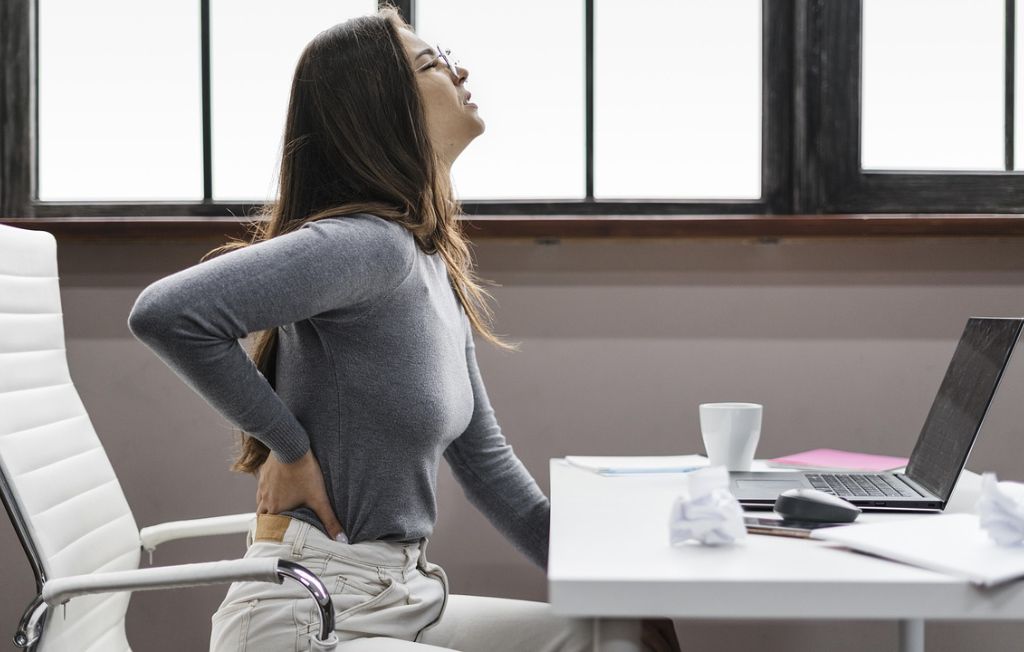Working in an office or remotely working from home can result in long periods of sitting down, wreaking havoc on a person’s spine.
Sometimes, people may sit on a less-than-ideal chair, resulting in poor posture. This can result in back and neck problems over time, possibly accelerating the degeneration of the discs and vertebrae and increasing the chances of spinal conditions and diseases.
This short guide will discuss the best ergonomic tips for office workers to help prevent back injuries. These tips are extremely easy to implement and can provide tremendous, long-term benefits.
The Risks for Office Workers
We humans are not designed to remain sedentary for long periods. However, many people work in office environments that force them to sit in front of a computer for long hours.
This has increased back-related problems as people develop bad habits such as maintaining poor posture or failing to take regular breaks to stretch their spine.
Lower back pain is said to be the most common medical ailment around the world, with some people suffering from chronic back pain that impacts their daily lives.
This can cause stress and even depression. This is why office workers need to make positive changes to their daily routine, especially if they have a history of back pain.
Back pain can indicate potentially serious problems that could require surgery. One such condition is spinal stenosis which refers to the narrowing of the spinal canal, resulting in the spinal cord and surrounding nerves becoming compressed. This can cause discomfort, pain, and a lack of mobility.
There are many ways to tackle these conditions, but as ever, prevention is always the best treatment for spinal stenosis, spondylosis, and other back issues.
7 Ergonomic Tips For Office Workers To Prevent Back Pain
Here are our 7 easy ergonomic tips that office workers can adopt to prevent back pain and other spine-related issues.
Take Swift Action
Too many people only take action when they are already experiencing back pain or have been diagnosed with a spinal condition.
At this stage, long-term damage may have already been done to the vertebrae, discs, or ligaments. This is why it is important to take action immediately, even if you are a young adult in good physical condition.
Ergonomic Office Chairs
An easy adjustment would be to purchase a back-support device that can be fitted to your chair. Or, better yet, you could even invest in a specially designed ergonomic chair to provide perfect posture.
Many office workers are turning to ergonomic chairs that have comfortable mesh backs and are specifically designed to encourage good posture. Such chairs can range in price but even a budget ergonomic chair is better than nothing.
You Might Like: Unexpected Connections Between Oral Health and Neurology
Consider Using a Standing Desk
An emerging trend in modern offices is the transition to standing desks. Not only are they better for a person’s back but they are also perfect for hotdesking environments where people are not designated specific workstations.
Standing desks take up much less room and people can simply just plug in a laptop and work wherever there is a vacant spot.

Standing desks encourage workers to keep moving and avoid poor posture by sitting down for hours on end. You could also have a stool nearby if you feel tired from standing now and then.
Practice Active Sitting
An ergonomic chair or a standing desk isn’t needed as long as you practice active sitting to protect your spine. Active sitting is based on kinesiology, with office workers engaging in therapeutic exercises while sitting.
To practice active sitting, a person should ensure that their feet are planted on the floor, they maintain a dynamic posture, and don’t apply too much downward pressure on the hip joint. This ensures the spine remains straight and encourages blood circulation.
Schedule Regular Micro Breaks
Consider setting a smartphone reminder each hour to prompt you to get up and walk around. This is one of the easiest but most effective ways to protect your back.
Regardless of how busy you are, taking a few minutes each hour to walk to the water cooler or around the office will allow a much-needed dose of oxygen to reach your spine while also stretching the ligaments and muscles.
Desk Stretches To Improve Circulation
Desk stretches take no time at all but can work wonders on your back, preventing deterioration in the spine and promoting better circulation.
Easy desk stretches to consider are:
- Rotating your neck and shoulder blades
- Gently stretching your forearms, wrists, and fingers
- Stretching out your back with your arms raised upwards
- Raising and stretching your legs and ankles
Use Your Lunch Break to Take a Walk
Typically, eating lunch takes a short amount of time, usually leaving around 30 minutes of free time on average. This free time can be used for taking a quick stroll.
Down to the local coffee shop, the park, or just a few laps around the building. This stops your back muscles from tightening during a long working day, helping you feel fresher in the afternoons.

Simple Back Pain Treatments
If your working routine is currently causing back pain or has caused back pain previously, then you may consider a few simple home solutions that won’t require a visit to the doctor.
Ice or heat packs to the problem area to reduce inflammation and improve blood flow. Any pharmacy will stock a range of heat or cold packs to experiment with. You could also try over-the-counter medications such as anti-inflammatories to reduce pain and swelling.
Daily gentle exercises can also be added to your morning routine. This could involve a 20-minute walk, swimming, yoga, and pilates.
Adjusting your diet to avoid inflammatory foods (like those that contain lots of fat) is also a sensible move. Carrying extra weight is one of the main causes of back problems so reducing your daily calorie intake can be beneficial.
Finally, you should try to adjust your sleeping position if you regularly sleep on your stomach. This can cause your back to take an unnatural position that could lead to a curvature.
Instead, sleep on your back or side and try to keep your body straight. You could even lodge a pillow between your knees to better position yourself.
Thanks for reading. We hope you and your work colleagues have found the tips listed in this article useful.





